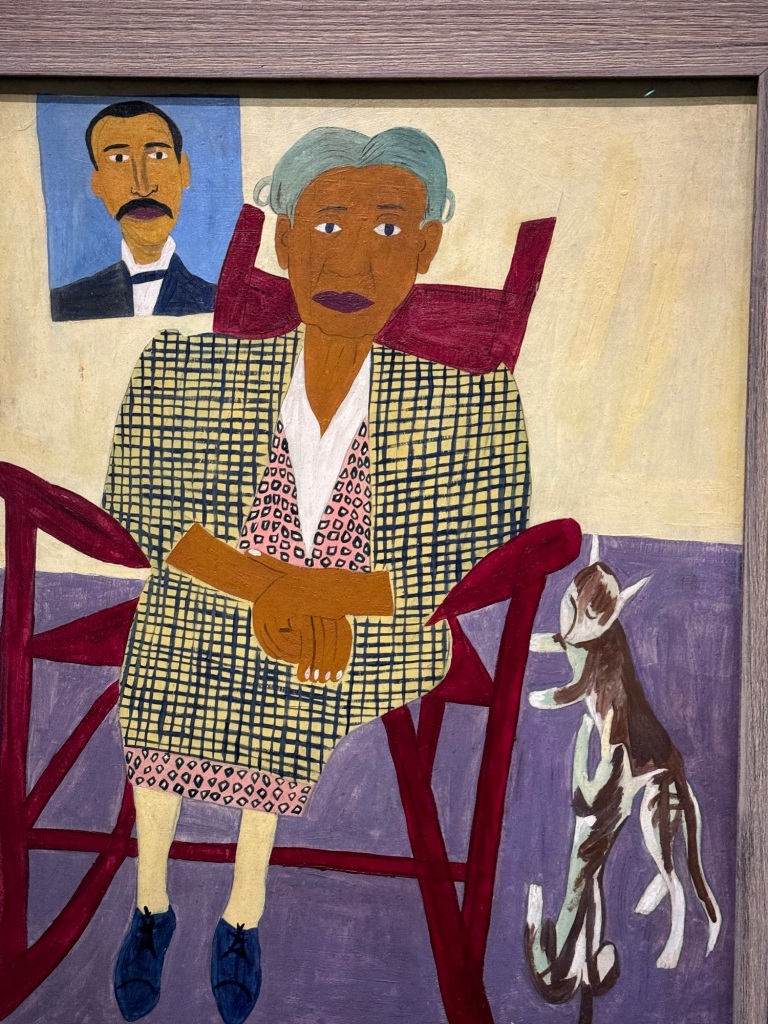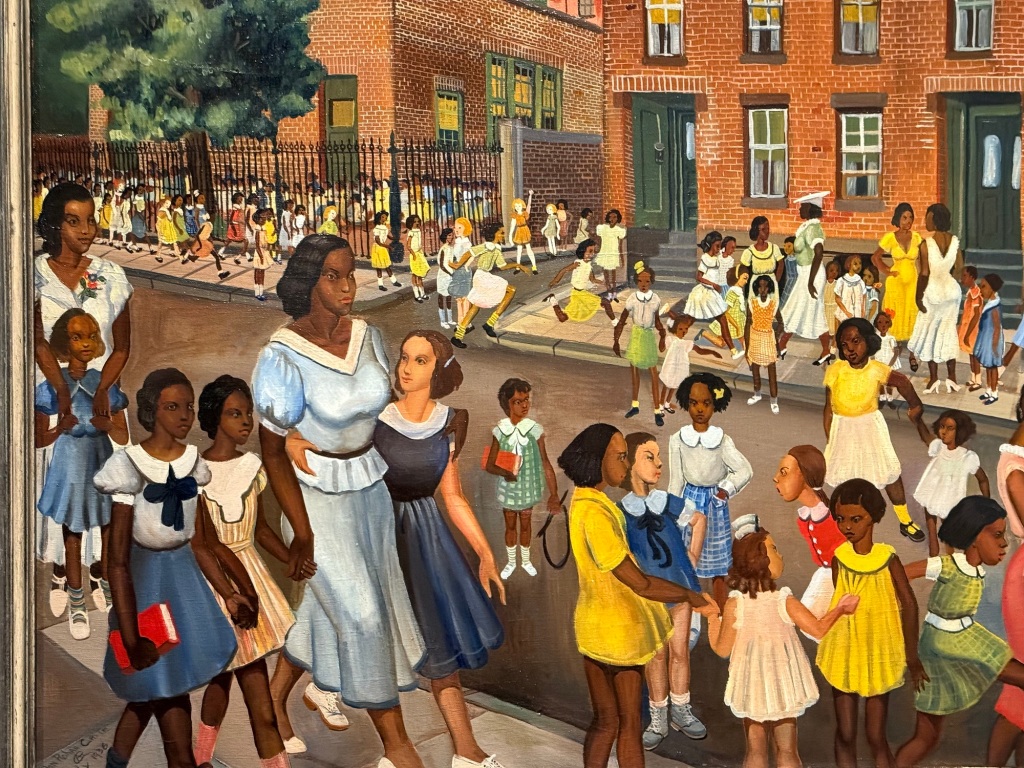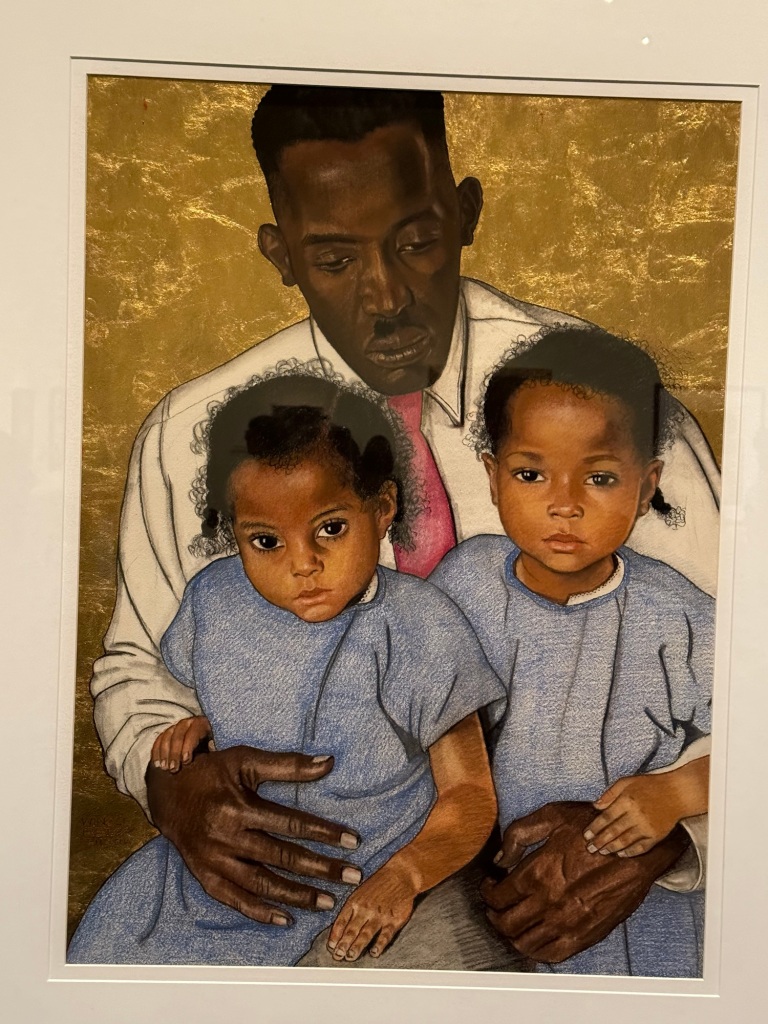I recently visited the Metropolitan Museum of Art, one of the world’s finest museums, to see a memorable exhibition. It’s called “The Harlem Renaissance and Transatlantic Modernism.”
It is a spectacular collection of works by and about African-American artists. The art is drawn from museums around the country. You may never see these artworks in one space again.
The quality of the art is breath-taking. I know that many of you don’t live in or near New York City, but this is a good reason to plan a trip. The show runs through the end of July.
Here are a few of the photos I took with my cell phone. I wish I had taken more. Some of the pictures are off-center because the crowds were large, and I didn’t have a clear path.

Painted by William H. Johnson (1901-1970), “Mom and Dad, 1944.” This folk-art painting of the artist’s mother and a portrait of his late father was borrowed from the Smithsonian American Art Museum.

Painted by Allan Rohan Crite (1910-2007). It is titled “School’s Out” and was painted in 1936. It depicts children emerging from Everett Elementary School in Boston. It was lent to the exhibition by the Smithsonian American Art Museum.

Painted by Aaron Douglas (1879-1979). Titled “Building More Stately Mansions, 1944.” It is owned by the Fisk University Galleries in Nashville. According to the artist, “his objective was to spotlight the contributions of exploited Black labor to great civilizations worldwide. He thus resituated African American history in a global context, in which the sphinx of Egypt appears together with the spire of a Western cathedral, the tiers of an Asian Buddhist pagoda, and a building crane extending over American skyscrapers, emblems of modernity meant to connote growth.”

Painted by Winold Reiss (1886-1953), who emigrated from Germany to America. It is a painting of Fred Fripp, a graduate of the Penn School and a teacher, with his daughters Carol and Evelyn. The painting is owned by the Fisk University Galleries in Nashville.
The caption of the portrait says:
“The sitter looks away in introspection while his young daughters gaze outward, settled into the security of their father’s steadying embrace.
“Reiss met Fred Fripp when he traveled to South Carolina to portray the Gullah-speaking Black residents of St. Helena Island, whose ancestors were among the last enslaved West African people forcibly brought to the United States. The luminous triple portrait, its triangular composition and gold leaf background reminiscent of Renaissance madonnas, celebrates Fripp as a teacher, scholar, and parent.”
As I viewed this magnificent exhibit, I kept wondering about the African-American artists. In their wildest dreams, did they ever imagine that their paintings and sculptures would one day be shown in the nation’s premiere museum?
The exhibition is a large and rich portrayal of the artists and intellectuals of the Harlem Renaissance. If you can’t get to New York by July 28, the last day, you might consider buying the catalogue from the Met.

I may go see this this weekend if I can get up early enough. The crowds at the Met are indeed brutal.
Yesterday, downtown, there was an exhibition devoted to the memory of the people slaughtered on 10/7. A large protest showed up, organized by Within Our Lifetime. Hamas and Hezbollah flags were flown. There was a huge sign that read “Zionists Are Not Jews And Not Humans.” Chants of “Long Live the Intifada.”
This is what I call the “dirtbag left.”
FLERP, so sad. Sadder still is that there are people, including friends, who insist that the protestors are not pro-Hamas. Frankly I don’t think they know the differences among Palestinian groups and terrorists.
Here’s a clip from last weekend, a large group of protestors (masked of course) in a subway car, chanting that if there any Zionists on the train, this is their “last chance” to get off. This has become so normalized. Poison.
https://x.com/henmazzig/status/1800554756957708488?s=46&t=vV_4bJ7GuABaalzetJofQA
Is harassing people on public transportation illegal? How about preventing them from using it? Isn’t the latter kidnapping? I hope these people were arrested and are being prosecuted.
They are not going to be arrested or prosecuted.
Well, that’s not good. This goes WAY beyond simple speech. It’s criminal threatening.
FLERP, disgusting.
I met a lady in Oxford, NY once. We talked to her a long time, learning that she was from Israel. I told her I hoped her relatives were ok ( there was some violence going on). She said “the Palestinians are not people.”
When is humans start down that road, it is hard to come back.
meanwhile, in Nashville, we celebrate the life of James Lawson who died yesterday at 95. King’s non violence teacher? The leader of the desegregation movement in downtown Nashville in 1960, Lawson trained a young John Lewis and others as the movement developed.
“School’s Out” looked familiar somehow. Turns out that’s because the Edward Everett Elementary School (universally known as the Eddie Eddie) is just down the hill and around the corner from my home. The outside of the building has changed little. Its student body remains pretty diverse, too. I love the face off between the girl in the blue dress and the one in the red. Some issue unresolved at the last bell.